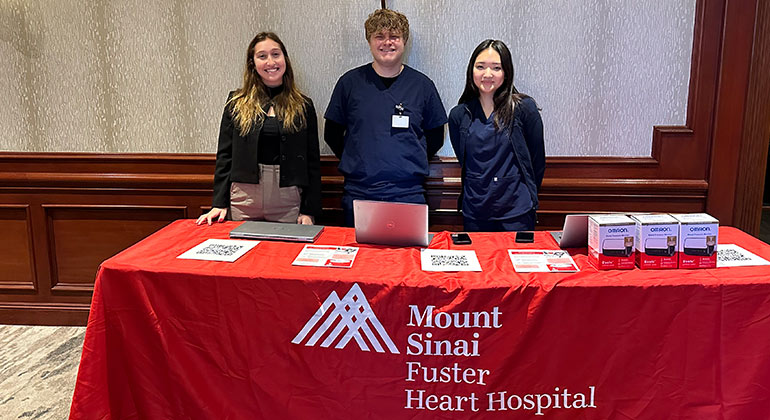
The Hypertension Prevention Program at Mount Sinai
At Mount Sinai, we work hard to keep you healthy. One way we do this is finding medical issues early when they are most treatable. Our hypertension screening program for New York City first responders is part of this effort.
Hypertension, also called high blood pressure, is the leading cause of line-of-duty deaths in the United States. While hypertension affects more than one in three Americans, it is even more prevalent among first responders. About three out of four first responders have the condition, which can lead to heart attacks and strokes. Early intervention is the best way to prevent heart issues.
The Hypertension Prevention Program at Mount Sinai is designed for active and retired members of the Uniformed Fire Officers Association (UFOA), the Uniformed First Responders Association (UFA), the Lieutenants Benevolent Association (LBA), and the Uniformed Fire Alarm Dispatchers Benevolent Association (UFDBA). It aims to reduce heart disease among New York City first responders through early diagnosis and treatment of hypertension.
Our program uses a self-monitoring approach. This means you will take your blood pressure regularly, and the team at Mount Sinai will review your results. We will let you know if there is cause for concern. Studies have shown that self-monitoring reduces blood pressure, improves patient’s medication adherence, and cuts down on primary care visits for heart concerns. Our monitoring services—including the blood pressure cuff—are available at no additional cost to union members.
If you need follow-up care, the Mount Sinai Fuster Heart Hospital at Mount Sinai West accepts most insurance plans, including those offered through your union.
Measuring Hypertension
Hypertension occurs when the pressure inside your arteries is elevated. Blood pressure is measured by using a cuff that wraps around your arm. You wrap the cuff around your upper arm, and the device automatically fills the cuff with air. This gives us two numbers. The first number, called the systolic pressure, represents the maximum strength of the pressure, the hardest your heart is working. The second number, called diastolic, represents the minimum pressure. We consider blood pressure to be concerning if it is 140/90 or higher.
Everyone’s blood pressure varies day to day and hour to hour. When you are asleep, your body needs less oxygen, so your blood pressure goes down. When you exercise, your muscles need more oxygen, so your blood pressure often rises. Caffeine and certain medicines, including oral contraceptives, cold remedies, and diet pills, can also raise your blood pressure.
Services We Offer
The Hypertension Prevention Program focuses on finding hypertension early, when treatment is easier and before complications develop. We offer three services:
- Patient education: We teach you about hypertension and how to take your own blood pressure. Topics include the role of diet, exercise, smoking, alcohol, and stress in controlling your blood pressure.
- Free cuff: Once you are enrolled in the program, your union will send you a blood pressure cuff, so you can take your own blood pressure.
- Monitoring system: The cuff uses Bluetooth to send your blood pressure readings directly to your phone as well as to our clinicians, who track your readings remotely. If your blood pressure is out of range, we will contact you to discuss possible interventions. You can also make an appointment with a cardiologist at Mount Sinai Fuster Heart Hospital at Mount Sinai West.
How the Program Works
Our program is open to all active and retired members of the UFOA, UFA, LBA, and UFDBA. You need a smartphone to take part in the program. To participate:
- Fill out the enrollment form and the lifestyle questionnaire. All forms are confidential.
- Review the HIPAA acknowledgement form to give us permission to monitor your blood pressure.
- When you have filed both the enrollment form and lifestyle questionnaire, you will get an email from us to complete enrollment and get a blood pressure cuff.
- Learn to take your blood pressure correctly.
- Confirm that your upper arm (bicep) measures between 9 and 17 inches in circumference.
- Receive two emails confirming your enrollment and providing further instructions, including information to download the app that you will use to track your blood pressure.
- Measure your blood pressure at least twice a week, at about the same time of day.
Once you are enrolled in the program, we recommend you take your blood pressure twice a week. You can set up phone alerts to remind you when to take it. You can also take a reading if you think your blood pressure has gone up or down so we can evaluate any concerns you might have.
The program team will monitor your blood pressure regularly to compare it to previous measurements and ensure it is within normal ranges. If we think you should seek medical care, we will contact you and discuss your options. You can see one of Mount Sinai’s cardiologists or another doctor of your choosing.
Your Information Is Safe
All your health care information is protected. We do not share it with your union or employer. If you choose a Mount Sinai Health System doctor, we can upload your blood pressure information into the Health System’s electronic medical record. If you would like your information sent to another health care provider, we require your written permission.